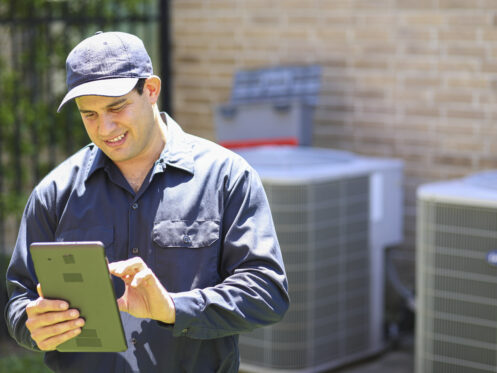Zoning the HVAC system in your Wheat Ridge, CO, home is a great way to modernize your property and save cash. Zoning systems incorporate cutting-edge, smart technologies for increased convenience, comfort, health, and efficiency. You can enjoy lower energy bills and a smaller carbon footprint, improved indoor air quality (IAQ), and easier HVAC maintenance. Read on to explore six impressive benefits that HVAC zoning supplies.
1. Customize Air Delivery Without Harming Your HVAC Equipment
HVAC zoning divides homes into multiple zones. Each service area gets its own thermostat, and residents can control each thermostat independently. This eliminates frequent disputes over thermostat settings by allowing everyone to establish their preferred temperatures in their immediate areas. Best of all, it does so without placing any additional stress on HVAC systems.
In the past, many people blocked the flow of unwanted air into their rooms by closing HVAC air vents. Unfortunately, vent closures place tremendous strain on heaters and air conditioners by increasing static pressure within HVAC air ducts. HVAC air vents are largely intended for making slight adjustments during air balancing to optimize airflow and ensure even temperatures throughout buildings. Closing vents off entirely is never recommended.
How Zoning Systems Mitigate Excess Air Pressure
Zoned HVAC systems have multiple duct dampers that divide air delivery routes according to established service areas. When heated or cooled air is no longer needed in a zone, the related duct damper seals shut. Bypass dampers alleviate static pressure by giving this unwanted air a place to go.
The movements of HVAC duct dampers and bypass ducts are coordinated by a central control center. When temperature adjustments are made, smart thermostats throughout the home transmit signals to the control center.
2. Experience the Enhanced Capabilities of Smart Thermostats
For a modern, zoned HVAC system, you’ll have to upgrade to smart thermostats. Neither standard nor programmable thermostats are sophisticated enough to drive these operations. If you haven’t experienced the enhanced capabilities of smart thermostats before, you’re guaranteed to be impressed.
These Wi-Fi-enabled devices are constantly learning. Not only can they hold multiple pre-programmed temperature settings, but they eventually grow adept at adjusting themselves according to residents’ habits, schedules, and locations as well. They also offer remote functionality. With their branded apps, consumers can adjust these devices from any location by using internet-connected laptops, mobile phones, or tablets. This way, if someone cranks their thermostat way up or down while you’re away at work, you can easily adjust it to a more moderate setting.
Optimize Your HVAC Maintenance Schedule
Smart thermostats also make HVAC maintenance a lot easier. You’ll get timely reminders to check and change your HVAC air filter. Some devices even remind consumers to schedule annual furnace, heat pump, or AC maintenance.
Capture Important Data About Your Energy Use
Many smart thermostats collect a wealth of information that helps homeowners identify developing problems and make informed purchasing decisions. You can track your energy and HVAC use throughout the year, quickly make comparisons of these things from month to month or year to year, and spot areas of energy waste. With this data, you can avoid using your HVAC system with ragged or torn ducting in hidden areas or with other issues that affect HVAC performance and drive up your energy costs.
Make Scheduled Temperature Adjustments for Energy Savings
Per ENERGY STAR, smart thermostats can help homeowners cut their energy bills by as much as 8% annually. These devices eliminate human error when it comes to making routine temperature adjustments, such as raising or lowering your temperature setting by several degrees before leaving for work or going to bed. When done correctly, the United States Department of Energy (DOE) estimates the potential energy savings of these adjustments as being as high as 10% annually.
3. Integrate Your HVAC System With Your Other Smart Home Features
Smart home technologies are finding their way into properties everywhere. From voice-activated entertainment systems, lighting, and security to automated appliances and window treatments, these additions make living spaces simultaneously more comfortable and more efficient. When these features are integrated, they work seamlessly together to optimize their overall performance.
For instance, if you have smart blinds for blocking solar heat during summer, your smart home can shut these features when the sun beats on your windows even as your smart thermostat makes coordinated temperature adjustments and your interior lighting dims or increases as needed. With your HVAC system working with all other features, you can enjoy both greater energy savings and the ability to customize every detail of your living environment.
4. Improve Your Indoor Air Quality
Zoning your home could have a surprising impact on your indoor air quality, especially if there’s someone in your household with pet allergies or other specific IAQ concerns. With separate service areas, you can isolate rooms that have litter boxes, pet beds, pet play structures, or other items that carry or release large amounts of dander.
Zoning also makes it a bit easier to keep airborne pathogens confined. When paired with air-cleaning technologies, it could help limit the spread of communicable illnesses.
5. Increase Your Home’s Marketability and Value
If you have an aging heater and air conditioner and a standard thermostat, your home is hardly on par with the most effecient options. Upgrades like zoning will ensure that your house isn’t lacking the modern amenities that otherwise comparable properties in your neighborhood have. You’ll be able to command a higher asking price when selling, and you’ll likely find it much easier to attract qualified buyers.
As energy costs rise and consumers become increasingly eco-conscious, HVAC zoning offers the high levels of efficiency that many savvy shoppers are seeking. After all, on its own, HVAC use can account for up to 45% of the average energy bill, especially during times of temperature extremes.
6. Extend the Lifespan of Your Heating and Cooling Equipment
Standard HVAC systems are built to heat and cool homes uniformly. In fact, if they aren’t doing this, they aren’t working correctly and they may have serious or fast-progressing problems. Although standard heating and cooling worked well when the average size of living environments was much smaller, they can be highly inefficient in larger and sparsely populated houses. For example, if you own a five-bedroom home but several bedrooms are unused and most residents are frequently away, you’re spending a veritable fortune to heat or cool large, unoccupied areas.
If you have a two-story home and everyone’s bedroom is upstairs, you’re spending money to heat or cool downstairs areas every night. With a two-zone HVAC system, you can eliminate or minimize the flow of conditioned air into unused spaces and keep your top floor at a more comfortable temperature. You can also have up to four zones created for a more customized experience for everyone.
Decreased heating and cooling needs reduce the amount of wear that furnaces, heat pumps, and air conditioners sustain. Thus, zoning could help your current HVAC equipment last longer. It can also reduce the occurrence of problems over time.
Homeowners in Wheat Ridge, CO, and the surrounding cities can count on us for top-notch air conditioning, heating, and electrical services. We also provide water heaters, indoor air quality improvements, and HVAC zoning. If you’re interested in zoning your HVAC system, contact Mighty Pine Heating & Air now for an appointment.



